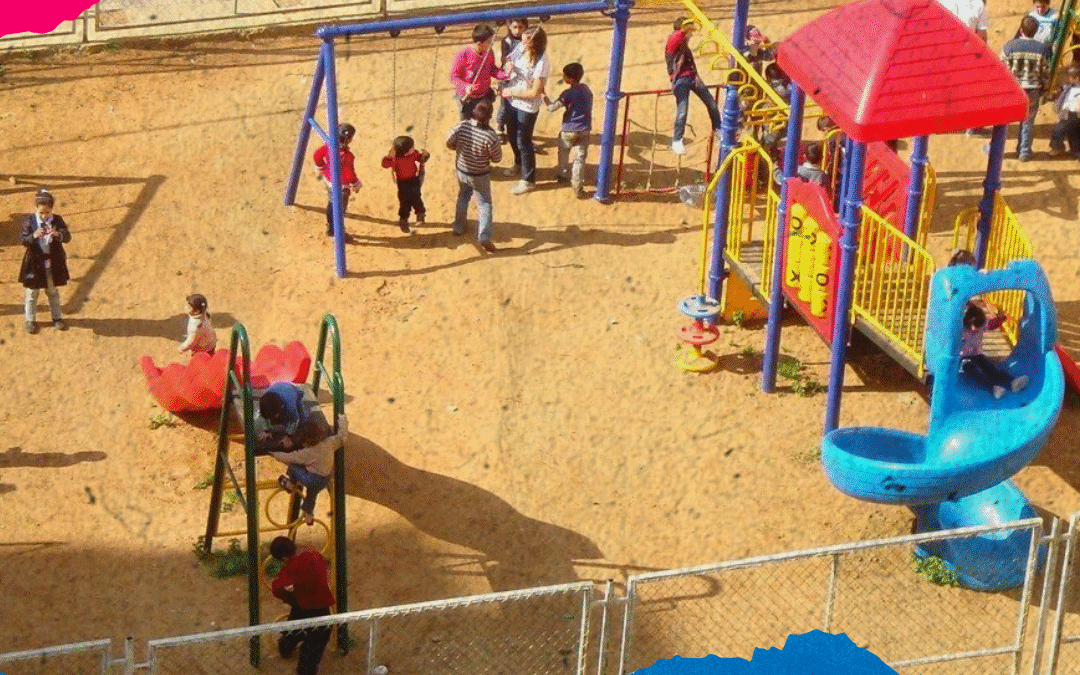The story I will tell is that of a playground that shaped me and my career. It is not the playground that comes to mind from my childhood, where I used to play, make friends and learn how to win or lose. That’s a different story. The playground I will tell you about is one of the first programs I led, early on in my career in the nonprofit sector, in Lebanon. I often reflect on this specific year, 2011. The year I was leading a project on the demarcation lines between two communities in continuous militarised conflict, where bombing and shootings took place daily. I often had to escape taking a special route there, to dodge bullets and snipers. And this experience taught me a lot about care, community and resilience. One of the initiatives we built was an inspirational playground and community center.
Let me share with you some of the early lessons from the playground project, where I experienced “community-centric successes”.
Designing with community
This project wasn’t just about constructing a playground; it was a process that took eight months of daily field trips, engaging activities with children and youth, and visits to all families in the neighborhoods. I was leading the team of volunteers, and, after spending some time in the area, decided that a one-time project will not be impactful. The community requested we support them year-long. What would our presence look like? We needed to figure it out; and we needed to do this with ALL the community. We visited (and had coffee) every person that invited us, and were welcomed by neighbors. We held town hall meetings and gatherings for mothers and fathers, community leaders and “hidden” neighbors, the ones who were often alienated from any decision-making in the neighbourhood. We asked children to draw, describe and dream of a better neighborhood. We meticulously gathered everyone’s inputs and insights.
By the end, what we had designed was more than just a playground; it was a center for after-school activities that stood as a testament to what can be achieved when communities come together. Community members chose the location, on the staircases between the 2 communities in conflict; easily accessible by both. Children picked the colors of the walls, youth helped in cleaning and painting, everyone added their touch. When we first proposed the idea, many thought it was a risk. They feared that the playground would be destroyed by the shooting/bombing. We proved that this project was for everyone. The center was left untouched, a colorful symbol of hope, throughout what seemed like endless wars and battles. Everyone, from both sides, owned it, protected it and wanted their children to be part of it.

Most importantly, the project logic was reflective of the neighborhood’s priorities. We didn’t need to name objectives, indicators and results; we had an understanding of what we want to achieve and do together. Children, youth and parents could explain the project, in their own terms. I had a theory of change and a logic framework; the basics that helped me coordinate and manage the project. This was an iterative process, aligned with outcome mapping principles.
This is where I learned the power of co-design. This experience shaped how I think about programming, how I collaborate and lead throughout my careers. I learned there the importance of asking the right questions, how to identify and engage those usually not included; and how to build ownership.
Avoiding the donor loop
One of the biggest challenges I’ve witnessed in international and local programs is the tendency to fall into the donor loop. This is when organizations prioritize the expectations and requirements of donors over the genuine needs of the communities they serve. While securing funding is crucial, it shouldn’t come at the cost of losing the organization’s authenticity and mission.
Going back to the playground, some of our donors were informed, through the design process. They understood the importance of our approach and supported it. This gave us space and trust; and didn’t expect a fully developed project. We were then able to plan ahead, and dedicated enough time to the design of the project. We kept donors in the loop; they responded positively to our requests.
While this might not be the case every time, we can look for ways to engage our donors into the process, and gather value-aligned support without feeling like we’re “selling our souls” in order to gather funding.

I’ve seen programs lose their way, becoming more about ticking boxes for donors rather than creating real impact. This is why philanthropic practices need to rely on trust and transparency. This ensures programs remain grounded in the needs and priorities of the communities they serve; and lead to actual impact.
Measuring impact and creating compelling stories
We often presuppose that we don’t need to speak about ourselves, our work will speak for itself. I have learned that we need to play a role in elevating stories and guiding the narratives. We need to be intentional, plan ahead and gather resources to do impact measurement. This goes beyond gathering feedback, or leading ad-hoc consultations. Evaluation can be embedded in the program’s design, and can be participatory and iterative. The results are truthful and inspiring stories of impact and concrete proof of success. Storytelling should be at the core.
The playground attracted journalists, supporters, and eventually more donors who wanted to engage in the project. Children, youth, and mothers told their stories in dignified and inspiring ways. It was their story, and they chose how to tell it. We regularly monitored the projects’ indicators, validated results with community members, and built compelling narratives that resonated with a wider audience.
Understanding aid/development
In many ways, aid or development can create dependency, whereby communities rely on external assistance rather than building their own capacities and solutions. Services can also alienate or even harm the communities’ autonomy or cohesion if they are not carefully co-designed. In contrast, I have also seen the power of participatory programs that focus on community engagement and systems change. These programs put the onus on communities to take ownership of the initiatives and collaborate together. The experts adapt impactful evidence-based initiatives to each context. This approach not only leads to more sustainable outcomes but also fosters a sense of agency among community members.

In the playground project, we reflected on the power dynamics that we wanted to change. We knew that some things were not fully within our control. There was a systematic and intentional marginalization of the area. Throughout informal discussions, we talked about oppressive systems, we talked about bridging differences, about justice. I remember children coming to me with all sorts of solutions: “let us sleep in each others’ houses tonight, across the demarcation lines; this way nobody will shoot”. And youth from the area telling me: “We feel cared for and dignified; leaders don’t treat us like this”. We didn’t take sides, we didn’t preach; we were there for them. We listened, we showed kindness, and we stayed true to our promises.
A continuous source of inspiration
I often return to the story of the playground throughout the dozens of programs I have been engaged in. It brings me joy to share this experience with my community, the team, and the organizations we serve. It reminds me of a particularly peaceful time. In the middle of conflict and pain, I felt at peace. I had the absolute conviction that I was doing something relevant. At that time, politicians and leaders had other plans for the area, and wanted war to continue. And then, a couple of years later, youth from the area marched the streets and announced the end of fighting. It was a surprise for everyone. I looked at the faces of those young ones shouting peace. I closed my eyes and saw the faces of all the children from the neighbourhood; they now had peace.
The success of the playground project was not an isolated event. This experience was a fundamental lesson in how essential it is to involve those who are most affected by the projects from the very start, ensuring the solutions are truly theirs AND is built based on best practices and sound evidence. It strengthened my feminist and community-centric beliefs and provided me with a model, a core practice for us at YAMM Services.

PS: I still carry the dreams of those young ones; they are now adults. Some of them got to have careers or better lives; the majority didn’t. The neighbourhood is still navigating systemic marginalization and intentional impoverishment. I still hope that one day they will be free and achieve their dreams.
Author Bio
Janine is a nonprofit leader and a certified fundraiser who enjoys helping meaningful nonprofits to grow. She builds on her wide experience to build a context-specific and adapted strategy for every organization she works with. She loves to solve puzzles, take long walks and learn new things.

